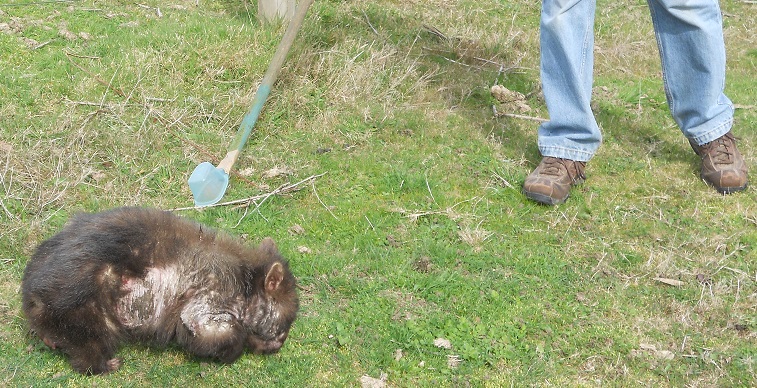Is mange in wombats a serious welfare issue?
Mange is a parasitic skin infestation which, if left untreated, can cause crusting, bleeding and intense irritation. In wombats and other animals, including humans, it is caused by Sarcoptes mites, which are microscopic insects that burrow into the skin. Severely affected animals have difficulty walking and eating, and lose a substantial amount of weight, resulting in a slow, painful death. Without effective treatment, infested wombats rarely survive, with death usually resulting from secondary infection, making mange a serious welfare issue.
What happens to wombats with mange?
Infested wombats show hair loss, skin thickening and crusting. Severely affected animals scratch excessively, increasing the risk of blowfly strike and severe skin infections which are fatal. Despite being nocturnal, affected wombats will often be seen during the day foraging for food because of the high energy demands resulting from the need to fight the disease and for maintaining body temperature (as unable to due to hair and body fat loss), especially during cold weather. They may appear hunched, emaciated and be walking oddly due to the pain associated with the scabs splitting and bleeding.
Not only does sarcoptic mange cause severe suffering but it has been reported to be a major threat to the survival of isolated populations of the bare-nosed wombat [1].
Spread of the parasite is thought to be due to wombats spending time in different burrows where infested wombats or other animals, such as wild dogs and foxes have inhabited.
Can mange be treated?
Treatment of free roaming wombats is a significant challenge due to the difficulties in ensuring sufficient treatment chemical is applied appropriately for an extended period of time [2]. Some dedicated wildlife carers have been successful in treating the disease in individual wombats but this requires an ongoing commitment. Research is needed to develop more effective and practical treatments to prevent future wild populations of wombats suffering and to help preserve this species.

Photo courtesy: WPSA – Wombat Protection Society of Australia
Wombat with mange being treated.
How you can help
Look for and report any wombats through WomSAT (Wombat Survey and Analysis Tools), a community program which has been established to help map reported sightings of wombats and their burrows. This is important work to help conserve wombats, who play an important role in maintaining soil health and whose burrows provide shelter for many other wildlife species.
References
Martin AM et al (2017) Invasive pathogen drives host population collapse: Effects of a travelling wave of sarcoptic mange on bare-nosed wombats. Journal of Applied Ecology, 1-11.
Old J et al (2017) Sarcoptic mange in wombats: A review and future research directions. Transboundary Emerging Diseases, 1-9.
Was this article helpful?
This work is licensed under a Creative Commons Attribution-NonCommercial-NoDerivatives 4.0 International License.


